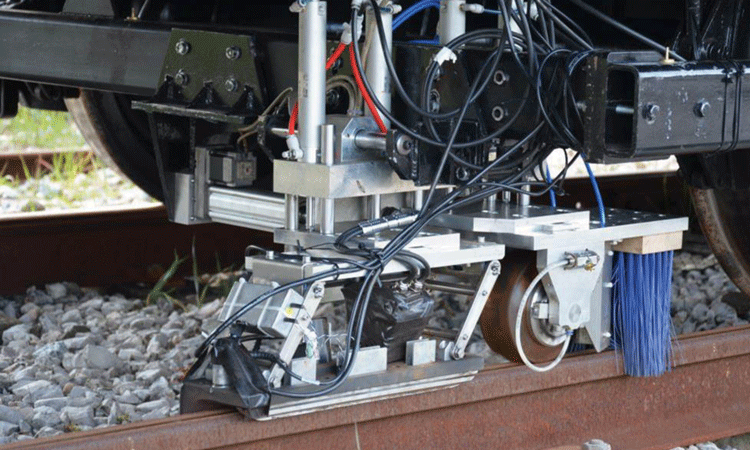Track maintenance – rectification of geometrical deficiencies
Posted: 21 May 2014 | João Gonçalo Maia Vieira, Ricardo Alves | No comments yet
Geometrical deficiencies in rail tracks tend to occur after a given period of time, all depending on how intense the traffic is or on how inherently instable the track foundation may be. The identification of such deficiencies through measurement and its correction is fundamental for the efficient and safe performance of a railway and therefore subject of a substantial share of the maintenance budget of any infrastructure manager. How is this particular aspect of track maintenance performed in Portugal? Explaining more is Ricardo Alves, Track Engineer at REFER Engineering S.A., and João Gonçalo Maia Vieira, Head of the Inspection and Diagnostics Department at REFER.


Track measuring work and maintenance planning
REFER – the Portuguese rail infrastructure manager – is continuously improving its track maintenance plans and procedures. There is a deliberate intention to ground interventions on the know-how of track maintenance, combined with the measureable knowledge of infrastructure status, by means of ever more diverse and precise inspection systems, allowing predicting and prioritising the necessary maintenance activities.
It has been almost 50 years since the Portuguese infrastructure manager bought its first track inspection vehicle and it has been systematically evaluating the infrastructure ever since. It started out with a self-propelled vehicle that would measure track geometric parameters with a contact chord system with a maximum inspection speed of 30km/h, only adding a computer in 1980. Running with speeds of up to 120km/h, REFER is currently working with an updated vehicle and inspection system, allowing the evaluation of all track geometric parameters with an inertial system, rail profile wear and corrugation with independent laser systems, catenary static geometric parameters and also track gauge with a laser system, plus ballast contamination with ground penetration radar.
Though personnel started using very basic ultrasonic equipment in the 1950s for localised verifications (joints), REFER has been completely self-sufficient in terms of continuous rail inspection since 1980. A fully dedicated team of experts covered the entire Portuguese rail network in terms of ultrasonic inspection, finding and classifying all different types of rail defects. Safety and productivity issues associated with manual continuous inspection led to the first sub-contracted continuous ultrasonic inspection campaign in 2010. Even with an annual inspection campaign covering most of the network, the know-how gained over 30 years of ultrasonic experience, naturally fixed maintaining in-house all manual verification of the primary results collected from the vehicle’s inspection.
The current maintenance strategy is based on the internalisation of most of the inspection, as a way to retain know-how and condition based knowledge within the infrastructure manager. The plan is to maintain and develop all current fields of inspection, as adding important new areas to work on. On-going refurbishing and developing of a new inspection vehicle, starting with the evaluation of the dynamic geometric parameters of the catenary infrastructure, will follow with plans to develop in-house capabilities related to the ultrasonic continuous campaigns. REFER is also evaluating the advantages and the possibility of adding a system dedicated to the visual and laser inspection of the track major constituents.
REFER is increasing the number of personnel dedicated to the inspection of the Portuguese infrastructure – namely ultrasonic experts and new teams for switch and crossing evaluation. The latter is a new area where REFER is determined to internalise the inspection component – however, maintaining for the meantime all sub-contracted maintenance activities in switches and crossings. The extensive training programme of these teams is on-going in order to fully assume the activity in 2015.


REFER’s EM-120 track geometry recording car
All of this knowledge coming from the inspection directly supports all maintenance operations. The different layers of factual data gathered overtime, analysed in combination with all the previous implemented maintenance activities and subsequent results, together with the strong maintenance know-how collected from the maintenance teams spread along the network, allows for full diagnostic – even of the more complex matters. Evidences of the necessity to intervene, risk analysis and strategic orientations, are all inputs to the definition of the operational (short-term) maintenance plans.
Operational maintenance plans are now a part of REFER’s asset management planning. Developing these capabilities will increase the robustness of condition based activities and expenditures forecast. Having an asset degradation model for track will enable REFER to predict activity volumes and costs in the long-run (20 years), complementing strategic orientations with the life cycle cost analysis of the different types of assets.
As the short-term maintenance plan (established for a timeframe of three years) is evermore the result of a combined effort to analyse technical, financial, operations and strategic inputs, it is often necessary to find support in the know-how concentrated in REFER’s engineering branch, in order to define the most adequate approach to the railway system. Focusing on track geometric parameters, it is usual in maintenance to identify sections requiring tamping that also indicate the need for a more specific study in terms of track geometry correction. Sections of track with fixed points such as bridges with no ballast, switches, crossings and other constraints to the track geometric correction, are frequently forwarded for deeper analysis in order to produce the optimum applicable study during tamping, promoting the effectiveness and long durability of the intervention.
The data obtained by track measurement is invaluable both for the planning of the maintenance tasks needed to be performed in the immediate future and for long-term analyses, where it is accessed if upgrades in the track structure or in its foundation are necessary. In the latter, such upgrades are carried out by contractors under the supervision of REFER with the aim to reduce maintenance cycles – especially tamping and lining of the track.
Obtaining relevant data on track geometry is also essential to financial planning. If a given rail track has geometrical deficiencies and these are not corrected, a lower speed limit must be imposed as a safeguard against accidents. Such speed limitations cause delays to the trains and so REFER – as the infrastructure manager – has to pay indemnities to the operators for such track-related delays. Over time, the amount of those indemnities is far higher than the cost of addressing the causes of the deficiencies in the first place, either by ballasting, tamping and lining the track or, if such is the case, by a more thorough intervention in the track infrastructure.
The analysis of the recorded data on a long-term basis also gives a reliable indicator of existing pathologies in the drainage system of the track. Insufficient drainage is, in many cases, the origin of track instability, leading to geometrical deficiencies that deteriorate the efficiency and safety of the railway exploration. Furthermore, an instable foundation leads to internal stress instability in a continuous welded rail and therefore results in the buckling of the track.
Correcting geometrical deficiencies by tamping and lining
As the track segments with geometrical problems are identified by the measurement works, a maintenance plan is established whereas the ones with a more difficult planimetry (i.e. interconnected curves or fixed points such as bridges, switches or station platforms) are subject of specific planimetrical studies. For such studies, complementary data is collected ‘in situ’ usually by the team charged with the calculations.
The planimetrical study generates a series of values for the parameters (cant, cant gradient, curve radius, warp, etc.) that have a significant effect on curve performance which includes safety, passenger comfort and wear and tear of equipment and rails.
These studies are supplied for the maintenance team that is going to perform the tamping on each branch of the rail line and are compatible with the software used in modern tamping machines.
Immediately after the tamping and lining comes the process of dynamic track stabilisation in order to anticipate the initial settlements of the track structure in a controlled way. Thus, not only more durable track geometry is obtained but also its resistance to lateral displacement is increased.
Effectiveness of tamping and lining
Over the years, experience has showed that track tamping is only significantly effective in the correction of geometrical deficiencies in lines that have a stable foundation and at the same time a superstructure still in good condition. Track branches that suffer from poor drainage or have a superstructure whose components such as sleepers or the rail itself are worn out have a much lower rate of recuperation for the parameters of levelling and alignment.
The results of this survey from our annual maintenance reports are categorical: the rectification of planimetrical deficiencies must go hand-in-hand with a sound investment plan in track upgrading. Unfortunately, such upgrades are unlikely to happen in the near future given the financially-strained situation of Portugal. Nevertheless, REFER will continue to strive to maintain safety levels in its network.




Issue
Related topics
Infrastructure Developments, Track Construction, Track Systems, Track/Infrastructure Maintenance & Engineering








